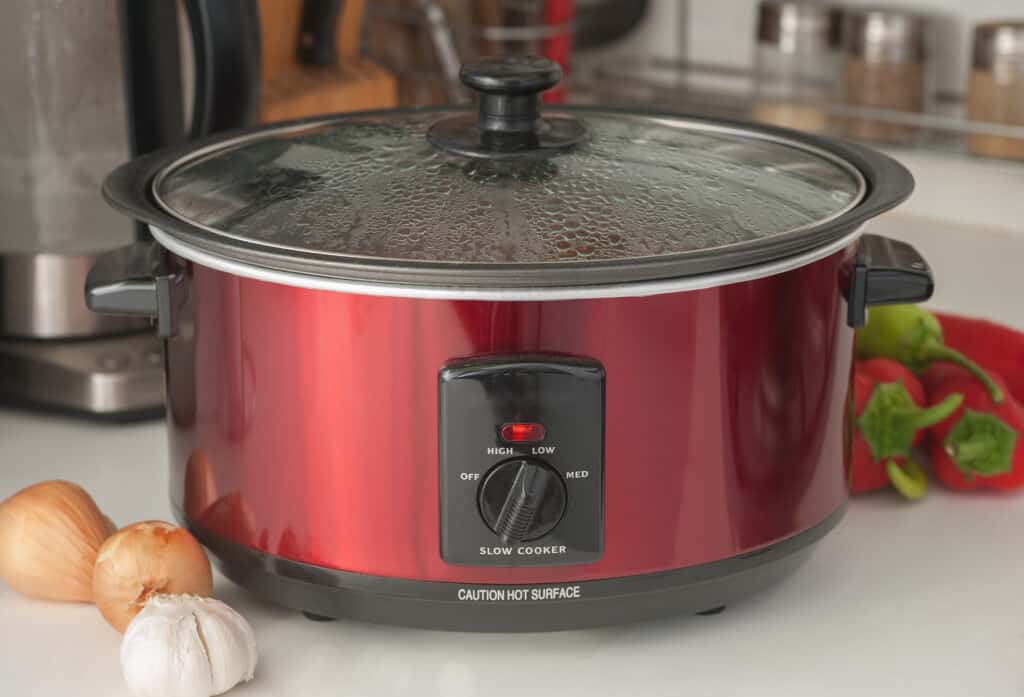When it comes to slow cookers, one question that often arises is whether or not you can use them without a lid. As a home cook, I’ve encountered this dilemma a few times myself, and I’ve discovered that using the appliance lidless can indeed impact the cooking process.
From my experience and research, I’ve found that it’s possible to use a slow cooker without a lid, but there are certain adjustments that need to be made to ensure the meal is cooked to perfection. In the following article,
I’ll discuss the pros and cons of using a slow cooker without a lid and share some tips on how to make it work effectively for your culinary creations.

Using a Slow Cooker Without a Lid
In this section, I will discuss my experience and knowledge about using slow cookers without a lid. Let’s cover the pros and cons first, followed by exploring some alternatives to lids.
Pros and Cons of Using Slow Cookers Without a Lid
From my experience, a major advantage of not using a lid is that it allows me to monitor the food better. I can quickly check if it’s cooking evenly, make adjustments if needed, and stir without losing much heat.
However, there are drawbacks. Cooking without a lid increases the risk of losing moisture and heat, which may extend the cooking time. Additionally, without proper covering, food in the slow cooker becomes more susceptible to contaminants.
Alternatives to Lids for Slow Cookers
Despite the challenges, there are alternative ways to cover a slow cooker. One option I’ve tried is using aluminum foil. Wrapping the top of the slow cooker with foil helps trap heat and moisture while also allowing me to easily check on the food when necessary.
Another option is using a plate, dish, or even a chopping board as a temporary cover. These items are generally flat and can fit well on top, providing an effective seal to keep the heat inside. However, it is essential to exercise caution, as these makeshift solutions may not be as stable or reliable as a proper lid.
Tips for Slow Cooking without a Lid
In this section, I’ll provide some useful tips for slow cooking without a lid, which can be helpful when your slow cooker’s cover is unavailable or damaged. I’ll discuss temperature adjustment and moisture retention, two key aspects of successful lidless slow cooking.
Temperature Adjustment for Slow Cookers
First and foremost, adjusting the temperature is crucial when using a slow cooker without the lid. Since the lid helps trap heat inside the cooker, you may need to increase the temperature slightly to compensate for heat loss. Monitor the food closely to prevent overcooking or burning.
Moisture Retention in Slow Cookers
Moisture retention is another important aspect of slow cooking without a lid, as the lid helps to keep the moisture in the pot. To maintain moisture levels within your slow cooker, consider using a bowl or dish to cover the top, or even tin foil. This creates a barrier that traps moisture and steam, ensuring your food doesn’t dry out.
Safety Precautions for Slow Cookers
When using slow cookers, it’s essential to ensure food safety. I always recommend starting with a clean cooker and utensils to prevent any cross-contamination or bacteria growth.
I cannot stress enough the importance of thawing frozen ingredients before adding them to the slow cooker. This is because a slow cooker cannot heat a solid block of ice quickly enough, putting the food at risk of spending too much time in the danger zone.
Even without a lid, I keep an eye on the temperature, ensuring it remains between 170°F and 280°F. It’s crucial to monitor the heat, as food will cook faster and may require adjustments to cooking time and temperature settings.
Following the manufacturer’s instructions for handling and cleaning the cooker is another step I take to ensure a safe cooking experience. This includes following specific thawing instructions for prepared frozen packages, if applicable.
Ultimately, while using a slow cooker without a lid is possible, it’s vital to be cautious and maintain safe cooking practices. This way, I can enjoy delicious, tender meals without worrying about any risks associated with improper usage of slow cookers.
Possible Outcomes
Taste and Texture Of Slow Cookers
Based on my experience, using a slow cooker without a lid can result in a different taste and texture in the cooked food. The lack of a lid allows moisture to escape, potentially leading to drier and less tender dishes.
However, there are alternatives that can be used to replicate the effects of a lid, such as aluminum foil or a ceramic plate. These options can help retain the moisture necessary for typical slow cooker results.

Cooking Time
Without a lid, slow cookers might take longer to reach the desired cooking temperature. The increased cooking time can be a result of heat loss due to the absence of a proper cover.
To compensate for this, I’ve found that increasing the temperature setting or extending the cooking time can help achieve the desired outcome. Keep in mind, though, that adjustments may vary depending on the specific recipe and alternative lid solution used.
FAQ
Can I use my slow cooker without the lid?
From my experience, using a slow cooker without a lid is not advisable. The lid is essential for sealing in heat and moisture, ensuring the food cooks correctly and doesn’t dry out.
What are some alternatives to a slow cooker lid?
Several alternatives for slow cooker lids are available. Personally, I’ve found that using a tightly-fitted sheet of aluminum foil can work to seal in heat and moisture. Other options, like using a tight-fitting pot lid, might also suffice in a pinch.
Can I put frozen meat in my slow cooker?
In my experience, putting frozen meat directly into slow cookers can be risky. The slow cooker takes longer than other cooking methods to reach the food safety zone temperatures, increasing the chances of food poisoning.
What happens if my slow cooker lid isn’t snug?
If a slow cooker’s lid has gaps or doesn’t fit snugly, it might not work as efficiently. I’ve found that wrapping a sheet of aluminum foil over the top can help seal in heat and moisture, allowing the cooker to function properly.
Are there any consequences of using a damaged or missing slow cooker lid?
Using a slow cooker with a damaged or missing lid can affect the cooking process. In my experience, it leads to moisture and heat loss, causing the food to dry out or not cook correctly.
Conclusion
In my experience, using a slow cooker without a lid is possible, but it comes with challenges. I’ve found that adjusting the cooking time and temperature is crucial to compensate for the loss of heat and moisture.
For those who might need an alternative, I discovered that a tightly wrapped aluminum foil or a ceramic plate can serve as a temporary cover. However, I would recommend purchasing a replacement lid for the best results.
Slow cookers are a convenient appliance for everyday meals, but taking care of their components, such as the lid, is essential for optimal performance. Keep in mind to never overfill your slow cooker and refrain from removing the lid while cooking, as it may affect the cooking process.
In summary, I suggest exploring the manufacturer’s recommendations on lid alternatives and always handle the slow cooker with care. By following these guidelines, I’ve managed to enjoy delicious, home-cooked meals without any issues.





